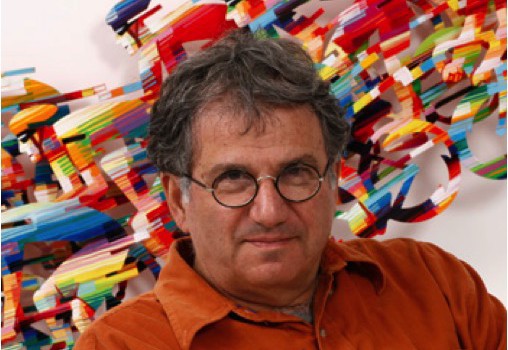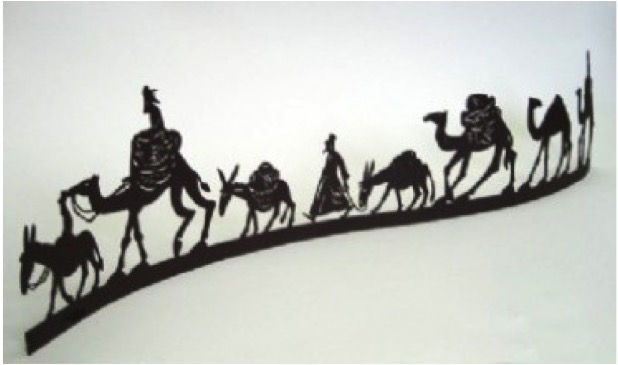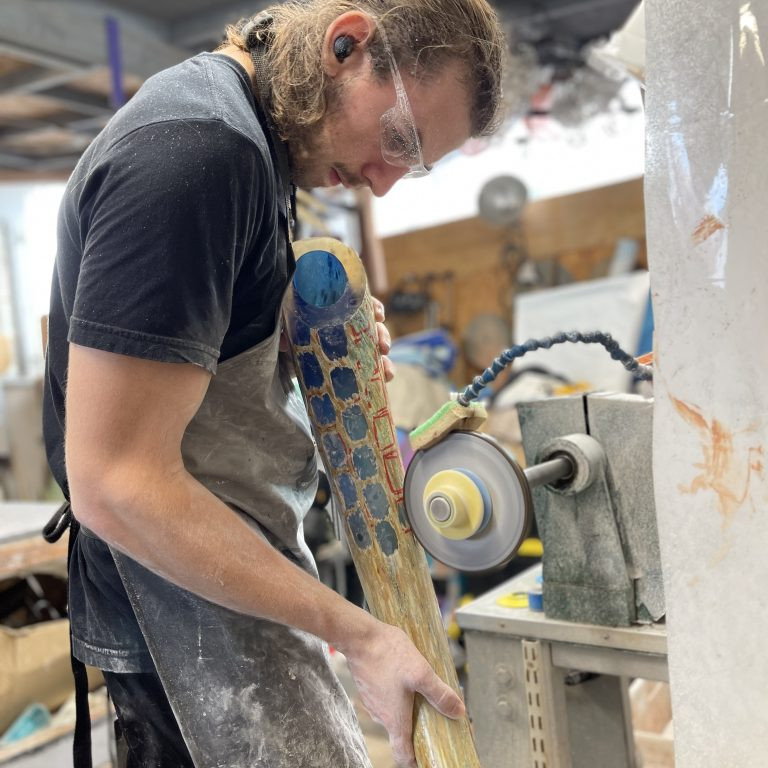David Gerstein Sculptor - Jerusalem, Israel
Your work is all about movement discuss?
Movement is indeed essential in my sculpture works and it has to do with the special technique that I am using which render itself very well with elements of motion. One of my early inspiration was comic films while the moving figures are cut out on the celluloid and move along the background. The repetitions of the figure while moving the body was used in my metal cut outs to create the sensation of movement that was lack in almost all the art works that I came across except in the futurist movement from the early years of the 20th century and that was abandoned for more than 50 years .When I abandoned paintings for cut-out sculptural images I enjoyed the freedom of the body detached from its background that always made it stable and motionless. Than my bicycle riders started to flow and many runners joggers, football players and others sport images became the centre of my interest. Since then I used many different motives most of them had the sense of movement.
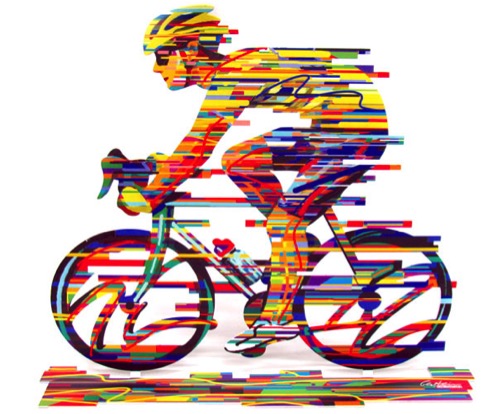
‘Champion’
How and when did you take your work from 2D to 3D?
After I finishing my studies of paintings I was immersed in figurative painting, rather narrative, that dealt with my own personal life and surroundings as well as childhood memories that need to be released to the world. I did a great deal of water colours as well as oil paintings in large formats.

‘Jogwoman’
It was unusual for a young ambitious artist not to join the very dominant conceptual or minimalistic styles in fashions at the early 70ties and I was considered as an artist away from the main stream. However I believed and insist on my ideas and paid the price for being unpopular by some one–track-mind critics. My heroes at that time were Hockney, Kitaj as well as Hopper, Lucian Froid and Picasso on top of all and they gave me the courage to do what I did. When I felt after 10 year the need to go on and find my own language I made my mind to search through sculpture a way to get my image a sense of volume and not merely illusionary. My intuitions led me to cut out the images from wood or cardboard separate them from the background and placed them in space while painting them from both sides. I also joined them together with other cut outs and enrich the scene so the viewer has to encircle the piece in order to see it all at 360 degrees and enjoy a bigger experience than what a flat painting could provide. From that moment on painting seems to me dull compare to the new possibilities the 3D could provide.
Your wall sculptures, how large can you make them?
The wall sculptures could be as large as I wish them to be. When the size grows I use thicker material to keep the strength and also could build them in parts so they joined on the wall to the required size.
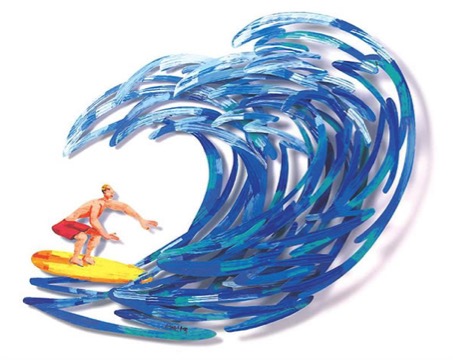
‘Surfer’
Can you discuss how your wall sculptures are hung?
They are joined together by screws that go through the holes I provide in every layer. Normally it hangs by two hangers that are placed at the tip of the top screws. Mostly two hangers are enough and then I provide two screws (hooks) on the wall and hang the wall sculpture just as a painting.
A different look is ‘Sharing a Cup Cake’. Please discuss?
If you mean the bronze sculpture of the 3 pigeons sharing a cup cake then it is a comment about the street pigeons eating all day long some dry pieces of bread given to them by people walking by. The cup cake was probably left by a child and becomes a first for the hungry pigeons. It could be regarded as a comment on our society: what is kicked by one – it is a find for the other.
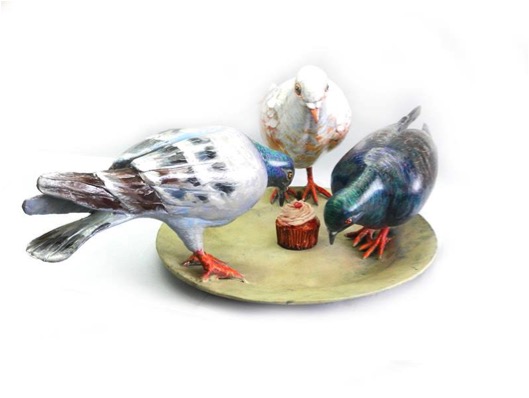
‘Sharing a Cupcake’
You have 5th Avenue – do you have any other district places?
No, the name came up as a memory I had from visiting New York but it could applied to any other city in the world: Beijing, Hong Kong or London. The world becomes very crowded and it’s the mirror to reflect our life in big cities.
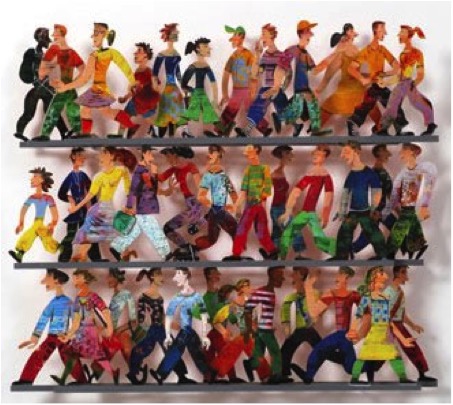
‘5th Avenue’
Bicycles, do you ride? Where did this idea or inspiration come from?
‘Bicycles’ started as an early memory of my mother riding at the age of 3 or 4 years old. Later I became a rider myself at school and I continue to ride even today. The image developed before it became a big trend worldwide. I love the integration between a man and the machine which manifest itself so beautifully with the bicycle. I also like the groups riding at great speed which looks like some kind of animal with many heads making its way through the open landscape. It’s a beauty. It became for me the meeting spot between colours and shapes and motion with emotions.
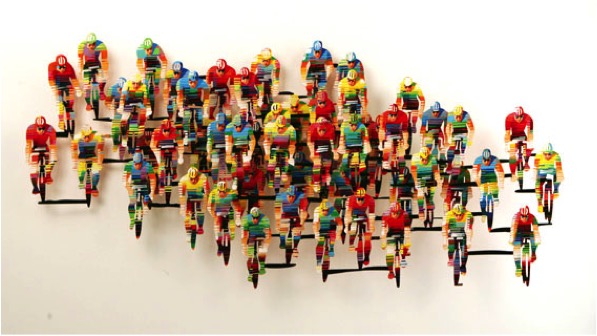
‘Tour de France’ – Horizontal
Your work ‘Sun on the Beach’ has a limited edition of 150. What is your normal limit or do you do specific sculptures in limited editions?
The cut-outs in metal are done by a laser cutting technology and once it is designed (which take a great deal of time and thinking) it seems to be such a waste to do only one piece .So I decided to create a limited edition in which every piece will be hand painted differently. It also helps to reduce the price and reach to bigger audience throughout the world. It is in fact still an original painting but not one of a kind. Beside that I do one of a kind paintings or sculptures as well.
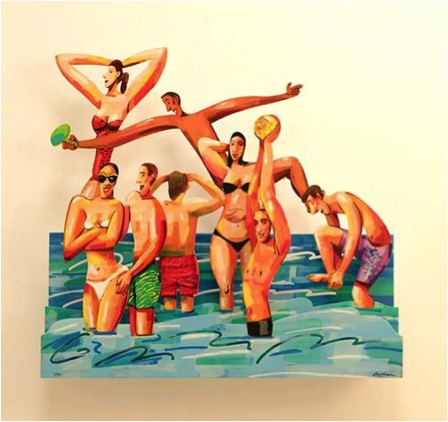
‘Sun on the Beach’
You also differentiate the forms by having one part black, giving stability while the flight or moment is full of colour. Can you discuss this in relation to ‘Happy Hours’?
The idea behind that composition is to create a tension within the art work between sketch-drawing and painting, black against colours, all together are moving elements in a different media. It is all about painting which start as a drawing and ended by applying colours to get more volume. The viewer can continue the painting of the two cyclists in his mind or enjoy the lightness of the drawing. The butterflies are getting more attentions and dominate the image leaving the riders on a lower scale.

‘Happy Hours’
Can you explain your installation outside the stadium in Taiwan?
How the commission came about?
What was the brief?
How was this constructed?
How was it delivered and constructed on the site?
Were you there for the construction?
Discuss the Opening?
The commission came as a result of an open international competition that I was asked to take part in and went through a few stages. My work passed the first screening and I had to do another final stage with five other finalists. Then I built models from cardboard and came to Taiwan to be interviewed by the committee which had to decide on the winner. After I got the commission I made a proper design with the help of engineers to construct it as strong as possible to make it stand any wether condition and to prevent it from collapsing.
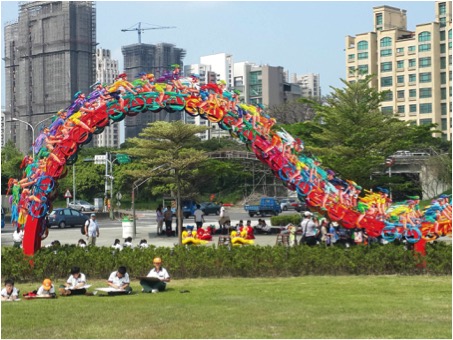
All the metal works were done in Taiwan and took about 3 months and I came from Israel with 4 assistants to do the complicated painting on the parts. We spent a month doing it and then the construction specialists assembled all the parts to erect it and made it possible.

I watched the progress through pictures that were sent to me by mail and was amazed by the high quality that it was made when I finally saw it…
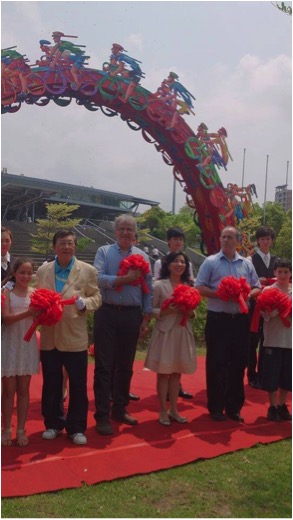 The opening was a great first with the participation of the Mayor of Sinchu and the Israeli Ambassador together with all the people who took part in the realization including my agent Ms. Virginia Hui-Ting Chen from Taipei that made it all possible. There were different performances and choral singing together with speeches in the event that lasted about 3 hours.
The opening was a great first with the participation of the Mayor of Sinchu and the Israeli Ambassador together with all the people who took part in the realization including my agent Ms. Virginia Hui-Ting Chen from Taipei that made it all possible. There were different performances and choral singing together with speeches in the event that lasted about 3 hours.
Have you ever been asked to do your work in neon?
No, I never used electric lights as part of my works and never tried it so far.
Your ‘Window’ pieces remind me of Matisse, can you discuss this?
Matisse is definitely one of many artists that inspired me throughout the years and I am sure it is rooted deep in my mind, Therefore I could only be pleased that it came out in that particular piece. I see myself a small part of huge Art machine that is shaping our understanding of the beauty of life and defines our place in the universe
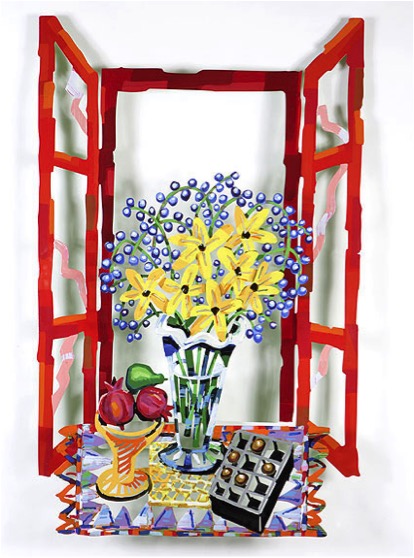
‘Table with Chocolates’
Your work is not always colour, colour and more colour. Expand on your Silk Way Sculptures in Ovda?
Using strong fresh colours is important part of my thinking and creation. In recent years it took more volume and people recognize my works from a mile away by that .However in many cases and other periods in my carrier other elements were more dominants and colours were used scarcely. In Ovdat project colours were out of the question because it was all about archaeology and ancient ruins and I wanted my works to integrate with the special atmosphere. I use colours where it is needed and not as a rule. I would even dare saying that drawing gives me more pleasure than painting.
Your work is sold in 21 countries around the world. Can you expand on one or two pieces that have given you great joy to know where they have gone and why?
It is a great pleasure to be recognized in many countries and to realize that the world accept my ideas and art without putting borders. When it appeals to a Chinese as well as someone in South America it means that I touch a mutual point that is common to human kind and that feels me with pleasure. My works speaks at eye level and are simple to understand at any level because it is honest and unpretentious. I believe that great music or literature could touch people anywhere if they reveal certain truth and reality. Sure it could not reach every one and luckily there are so many different tastes but having big audience is a great privilege.
My biggest sculpture so far is Momentum in Singapore and it brings me many regards from different people on many countries. This is why I like so much to do public works that everyone can see and experience.

‘Momentum’
Picasso said he never searched but he finds, I like that phrase. I would say that my art comes from what my mind produces without forcing it. I let my ideas float and goes with the stream of my imagination. Places I see, things that catches my attention, art that I like, things that I read or discuss, music I listen to, all inspire my creation and help push my creativity. I do not think there is one method for stimulating the mind, it depends on every person’s personality and it is perfect as long as one listen carefully to himself.

david-g‘Jazz in the City’
How do you record your ideas?
The only way I know is to draw in my sketch book. I  do it constantly almost every day and sometimes more than once. Than the ideas that I sketch could be forgotten even for some years and pop up again while I look through it and get excited again.
do it constantly almost every day and sometimes more than once. Than the ideas that I sketch could be forgotten even for some years and pop up again while I look through it and get excited again.
I also take photos all the time wherever I go, it is so easy today with cameras integrated in the mobile phone. The pictures reveals precious moments and reminds me of past experience or ideas that caught my attention and surely helps creativity to come to life.
I like to show my works to some people and listen to remarks, it does not mean that I would consider what people have to say but it helps to define my position and test my new ideas if they are ready to be delivered.
And last thing is that having no ideas is a good way to create something new. It throws the mind into chaos from which a new order comes out and surprises.
What are you currently working on?
I was invited to show next year in an imported museum in China and I am trying to crystallize my past ideas. On the other hand to recreate myself again, in other words to come up with something fresh and surprising .Let it be!
Contact Details:
Website:http://www.davidgerstein.com
Email: david@davidgerstein.com
David Gerstein, Jerusalem, Israel
Interview by Deborah Blakeley, November 2014
Think a colleague or friend could benefit from this interview?
Knowledge is one of the biggest assets in any business. So why not forward this on to your friends and colleagues so they too can start taking advantage of the insightful information the artist has given?
Other artists you may be interested in:


